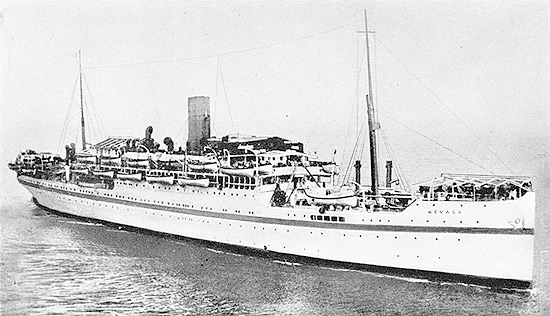Troopships and the Regiment
British India Line
Dilwara (ii), 1936, 11,080 tons, 14 knots, built as a permanent troopship carrying 104 1st class, 100 2nd class and 1,157 troops. She was the first purpose designed troopship. She trooped from 1936 until 1960 when she was sold to the China Navigation Co and put into service as a pilgrim carrier. Near-sisters were Devonshire (Bibby), Dunera (BI) and Ettrick (P&O). Broken up in 1971.
Dunera. Motor ship. Built in 1937 with a gross tonnage of 11,162, she was one of the first group of ships built in the late 1930’s to new Government trooping regulations. The others were her sister Dilwara, P&O’s Ettrick and Bibby’s Devonshire. She had an active life as a trooper world-wide until 1960 when she was converted to an educational cruise ship. Dunera carried 1 Queen’s Surreys from UK to Aden on her last outward-bound voyage (4th January to 22nd January 1961).
Neuralia. Built in 1912 with a gross tonnage of 9,082, she was the Nevasa and designed for the UK to Calcutta route. She was taken over as a troopship in 1914 and converted to a hospital ship in 1915. She reverted to trooping after the 1914-18 War and had a long and varied service. In May 1945, at the very end of the 1939-45 War, she struck a mine in the Gulf of Taranto and sank, having served as a troopship for over 30 years.

HMT Nevasa, 1913.
Nevasa (1913) Built in 1913 with a gross tonnage of 9,071, she was one of BI’s most celebrated troopers. During the 1914-18 War she served as a hospital ship. After the War she resumed passenger service but became a regular chartered troopship in 1925. During the 1939-45 War she served in many campaigns and was finally sold to be broken up in 1948. Like Neuralia, she too had over 30 years service in peace and war. The old Nevasa made 14 trips to and from France between June and October 1945, carrying over 27,000 men.
Nevasa(1956). Built in 1956 with a gross tonnage of 20,160. Near-sister of Bibby’s Oxfordshire, though somewhat different in outward appearance. Both ships were among the most attractive troopships ever built. Nevasa served as a troopship until 1962 when the Army switched entirely to air transport. She was then converted to educational cruising. She was sold to Taiwan for breaking up in 1975.
P&O S N Co.
Ettrick, 1938, 11,279 tons, 20 knots, built as a permanent troopship for 1,150 troops, torpedoed and sunk 1942. During the Second World War numerous passenger liners were requisitioned for service as troopships and some were not returned to their owners for several years after the war ended in 1945. Two of the permanent troopships, Neuralia and Ettrick, had been sunk during the war. On D-Day 1944 Lancashire was commodore ship for the troop carrying convoy ETP 1 sailing from the Thames to Juno Beach and led in line ahead her fellow Bibby liners Cheshire(ii) (1927 10,550 tons, 15.5 knots), Worcestershire(ii) (1931, 11,453 tons, 15 knots) and Devonshire.
Related
